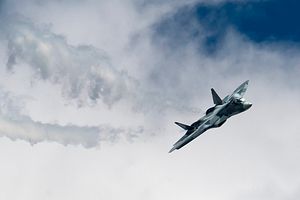The Russian Ministry of Defense (MOD) is expected to sign a contract for a pre-production batch of 12 Sukhoi Su-57 fighter jets, Russia’s first indigenously designed and built fifth-generation stealth fighter aircraft, Russian Deputy Defense Minister Yuri Borisov said on Thursday.
“We are buying Su-57 jets for test combat use. First stage state trials are over,” he told journalists, he said, according to a TASS news agency report. “This year, we will sign a contract for the first batch of 12 Su-57 fighter jets for the Armed Forces.”
The Su-57 is a multirole, single seat, twin-engine air superiority/deep air support fighter developed under the PAK-FA fifth-generation fighter program. The Su-57, which took to the skies for the first time in 2010, will replace the Russian Air Force’s existing stock of MiG-29s and Su-27s in the coming decade.
Russian efforts to field the country’s first fifth-generation fighter aircraft in the not so distant future are hampered by delays in designing and building a new turbofan jet engine for the Su-57. In December 2017, the aircraft made a first flight with a new engine prototype with mixed results.
Consequently, the Russian deputy defense minister was circumspect when talking about the new engine’s performance. “So far, it is difficult to say because there has been only one flight. Everything seems to be all right,” Borisov said today. “But you know, it is a series of trials. Many flights are to be performed. As a rule, such trials take two or three years.”
The new engine—purportedly called the Saturn izdeliye 30 — is not expected to be ready for serial production until at least 2020. “The Saturn izdeliye 30 will feature increased thrust and fuel efficiency and is also expected to improve the fighter jet’s stealth characteristics given the use of new composite materials,” I wrote in August 2017.
Nine out of ten Su-57 prototypes currently undergoing flight tests are fitted with a derivative of the Russian-made Saturn AL-41F1S engine, dubbed AL-41F1, an older aircraft engine also installed on the Sukhoi Su-35S Flanker-E. The new engine currently under development will be purportedly be capable of mounting 3D thrust vectoring nozzles, which will increase the Su-57’s maneuverability.
Once in service, the Su-57 will be able to carry both conventional and nuclear payloads, as I noted in December 2017:
The Su-57 will be capable of carrying some of Russia’s most advanced weapons systems including new beyond-visual-range air-to-air missiles and air-to-ground missiles including the extended range Kh-35UE tactical cruise missile as well as the nuclear-capable BrahMos-A supersonic cruise missile.
However, the price for carrying such a heavy weapons load will likely be reduced stealth capabilities (…) Both the BrahMos-A and KH-35UE do not fit into the aircraft’s internal weapon bay and consequently will need to be carried under the aircraft’s wings in a transport launch canister, which will reduce the fighter jet’s stealthiness.
The first two Su-57s are expected to enter service in 2019. Meanwhile, a derivative fifth-generation Indo-Russian fighter project, the co-development and production of the Sukhoi/HAL Fifth Generation Fighter Aircraft (FGFA), also known in India as the Perspective Multi-role Fighter (PMF), remains stuck, as I reported last month.
































